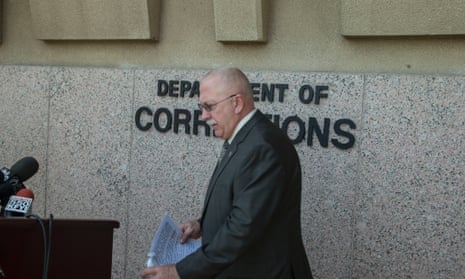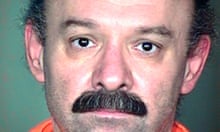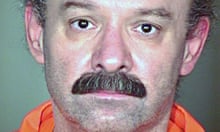As Joseph Wood lay on the gurney in Arizona’s death chamber, gasping and gulping, prison officials kept pumping execution drugs into the convicted killer’s system.
By the time Wood died, after nearly two hours, he had been injected with 750mg each of midazolam and hydromorphone: 15 times the amounts called for in the state’s execution protocol.
Wood’s death, on 23 July, was the third highly problematic execution in the US this year, following those of Dennis McGuire in Ohio in January and Clayton Lockett in Oklahoma in April, which were also drawn-out and led to accusations that the inmates may have endured a level of distress prohibited by the US constitution’s ban on “cruel and unusual punishment”.
The sedative midazolam was used in all three cases. McGuire’s death marked the first time a state had used it in a two-drug protocol with hydromorphone, a painkiller. Even before that execution, medical experts warned that the experimental combination risked being ineffective and causing undue suffering.
The revelation that Arizona injected Wood 15 times, amounting to a massive dose of the drugs, raises fresh doubts about the efficacy of the combination and the competence of those tasked with designing and implementing the procedure.
Wood, 55, was put to death for the murders of his former girlfriend, Debbie Dietz, and her father, Eugene, in Tucson in 1989. Arizona’s governor, Jan Brewer, said she was concerned about the length of the execution and ordered a review into the state’s processes, which the Arizona Department of Corrections said in a media release would be independent, “thorough, transparent and comprehensive”.
Arizona’s most recent execution before Wood, last October, took 17 minutes but used pentobarbital, a barbiturate. Drug shortages prompted by Europe-led sales bans mean that many states have resorted to new, often experimental, protocols.
Such states are also shrouding details of suppliers and procedures in secrecy, in response to mounting concerns about the suitability of lethal injection as an execution method. These worries have given anti-death-penalty campaigners fresh impetus and prompted numerous legal challenges, including in Wood’s case.
Eric Holder, the US attorney general, told PBS on Thursday he was troubled by the widespread lack of transparency and the recent prolonged deaths. A wide-ranging federal review of executions is ongoing.
Charles Ryan, the Arizona prisons department’s director, has rejected claims that the execution was botched and said that the prison’s medical team verified several times that Wood was “comatose and never in pain”. The doctor who carried out Wood’s autopsy told the Arizona Capitol Times the intravenous lines were placed correctly – unlike in Lockett’s case, according to reports.
However, medical experts told the Guardian last week that assertions by Arizona officials that Wood was “brain dead” during the execution are spurious. David Waisel, an associate professor of anaesthesia in Boston, said that simply increasing dosages, as Ohio has decided to do, is no guarantee that the drugs will be more effective at killing death-row prisoners.
“Twice the dosage is not necessarily twice the effect,” he said, adding that it was impossible to “know for sure” whether an inmate on the gurney is in pain or not.
Official prison documents released to Wood’s legal team on Friday indicate that he was injected with midazolam and hydromorphone 15 times. The state’s protocol gives the prisons director a degree of flexibility in how the execution may proceed, but only explicitly allows for “an additional dose” of the chemicals that can be administered “if deemed appropriate” after consciousness checks are performed three minutes into the procedure.
“The Arizona execution protocol explicitly states that a prisoner will be executed using 50mg of hydromorphone and 50mg of midazolam,” Dale Baich, one of Wood’s attorneys, said in a statement. Underlining the wide variations between states, Florida’s protocol calls for 500mg of midazolam as part of a three-drug combination.
“The execution logs released today by the Arizona Department of Corrections shows that the experimental drug protocol did not work as promised,” Baich said. “Instead of the one dose as required under the protocol, ADC injected 15 separate doses of the drug combination, resulting in the most prolonged execution in recent memory.
“This is why an independent investigation by a non-governmental authority is necessary.”

The documents show that the first syringe of midazolam and hydromorphone was administered at 1.53pm local time. Four minutes later, the “IV team leader” verified that Wood was sedated, according to the log, but he was not pronounced dead until 3.49pm. In between, some witnesses said they saw him gulp and gasp more than 600 times.
The procedure took so long that Wood’s lawyers were able to file a court motion for an emergency stay of execution. The telephone hearing with a federal judge lasted for half an hour. Wood’s lawyers asked the judge to call a halt to the execution and order Arizona officials to resuscitate the prisoner, but he died before the judge could make a ruling.
Friday’s documents show that a second syringe of 50mg of midazolam and 50mg of hydromorphone was injected at 2.09pm, and a third only four minutes later.
“Inmate remains sedated,” the log noted at 2.24pm. By 3.09pm, the “tenth drug protocol” was complete. At 3.30pm, the log simply stated, “inmate remains sedated”.
Finally, after the 15th drug protocol was completed at 3.46pm, a prison official wrote, three minutes later: “IV team leader pronounced death”.
There were no more entries.











Comments (…)
Sign in or create your Guardian account to join the discussion